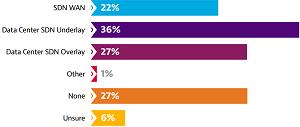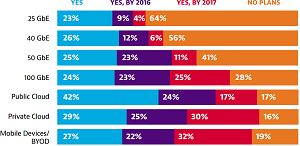News
Bandwidth Hogs Drive SDN Adoption, Study Says
The IoT is adding to the heavy toll of video data.
Right now, the world's insatiable appetite for video is driving the adoption of emerging networking technologies such as software-defined networking (SDN), but the burgeoning Internet of Things (IoT) is coming on strong to scoop up even more capacity, according to a new study.
The ninth annual State of the Network survey of IT execs and engineers around the world reveals that two-thirds of polled enterprises have adopted SDN, according to Viavi Solutions, which conducted the study in March.
"With 35 percent of respondents implementing SDN underlay, most respondents appear to be relying on hardware vendors, such as Cisco, Brocade and Big Switch for SDN initiatives," the survey report said. "This compares to nearly 27 percent using an SDN overlay technology from vendors like VMware."
Viavi sees an acceleration of SDN adoption reflected in the new survey, which it compared to previous findings.
"In contrast, in the 2015 study, SDN adoption by the end of 2016 was projected to be 51 percent, with slightly less than half of respondents saying they had no plans at all," the company said.
Viavi also had some advice for IT service deliver teams, based on its findings.
"For SDN deployments, groups must validate monitoring solutions support their technology architecture of choice including awareness into underlying communication protocols like OpenFlow and VXLAN," the company said. "Otherwise visibility into control and encapsulated data plane traffic may be compromised and service levels negatively impacted."
 [Click on image for larger view.]
SDN Adoption (source: Viavi Solutions)
[Click on image for larger view.]
SDN Adoption (source: Viavi Solutions)
Other emerging technologies seeing increased deployment are 100 GbE interfaces and cloud services, with a bent toward the public cloud over the private cloud.
In fact, nearly 90 percent of polled enterprises have one or more applications running in the cloud, while 28 percent actually house most of their apps with cloud service providers.
On the bandwidth front, nearly half of survey respondents see bandwidth requirements doubling by the end of next year, after seeing 50 percent growth this year. Some 25 percent have already deployed 100 GbE.
"Data networks of all types, around the globe, are being strained by an explosion of traffic, from bandwidth-hungry video today to the Internet of Things tomorrow," said Viavi exec Oleg Khaykin. "As our State of the Network study shows, IT teams are responding by moving faster to implement emerging technologies, giving them the cost-effective scalability and flexibility they need. Of course there will be ensuing challenges, from the unique installation and maintenance requirements of 100 GbE, to the loss of performance monitoring capabilities for networks spread across physical, virtual and cloud segments."
Top amongst those challenges in the cloud space are "loss of visibility and control" and "SLA enforcement," both found at least somewhat challenging by 90 percent of respondents. The former ranked first (37 percent) in the "very challenging" category.
The top reason for moving to the cloud is to "lower operating expenses," cited by 62 percent of respondents. Second place was shared by "decreasing capital expenses," "improving ability to provision network resources" and "improving service availability," all reported by 53 percent of respondents.
"One quarter of respondents indicated that their companies are running the majority of applications in the cloud," the survey report said. "This will double in 2017 with nearly half of respondents running the majority of applications in the cloud."
 [Click on image for larger view.]
Emerging Technology Deployments (source: Viavi Solutions)
[Click on image for larger view.]
Emerging Technology Deployments (source: Viavi Solutions)
Beyond cloud issues, other challenges listed by respondents include application troubleshooting anxiety, Viavi said. Sixty percent of respondents said "tracking application bugs and patches" is an issue, followed by "measuring latency and delay issues" (54 percent), and "determining whether problems caused by network, system or apps" (51 percent).
"For every year of the State of the Network, the top application troubleshooting challenge has been isolating the problem to the network, system or application," the company said. "Compared to last year, that challenge has moved to the No. 3 position. Noteworthy for 2016 is the relatively high number of respondents having difficulties tracking application bugs and patches (nearly 60 percent). This concern ranked at No. 1, for the first time in the nine years of the study. When tied to the rapid growth of cloud deployment, it may indicate additional challenges to moving hosting outside of the internal datacenter."
Revisiting the ever-growing need for more bandwidth, Viavi said the acceleration of demand for higher capacity is clearly a factor driving the deployment of bigger network pipes. "In the 2015 study, 14 percent of respondents expected bandwidth to double by the end of the second year (2016); in this year's study, 48 percent expect bandwidth to double by 2017," the report said.
Faster interfaces are being deployed to meet this need, but at different rates. While organizations have been adopting 25 GbE and 40 GbE at a fairly consistent pace, that's not the case for 100 GbE.
"Enterprises are signaling a shift to 100 GbE, with one in four also having implemented it, and two out of three planning to do so by 2017," Viavi said. "Of particular note is that in 2015, 56 percent of respondents said they had no plans to deploy 100 GbE, and in 2016 that number has dropped to 28 percent."
Viavi said that enterprises will probably need to redesign installation, monitoring and troubleshooting processes as the 100 GbE interfaces are rolled out in order to sustain acceptable performance visibility. IT teams must also be proactive in providing for comprehensive monitoring of hybrid environments that can see resources housed in public, private or legacy infrastructure.
The company also had further advice for IT service delivery teams. It said: "Given the demands on network resources and the diverse responses available, it is more essential than ever for the traditional IT silos -- including server, network, application, security, and infrastructure groups -- to closely collaborate for optimal service delivery levels."
Viavi polled 740 respondents -- network engineers, IT directors and CIOs -- around the world via online surveys from March 10 to March 28. The study population was evenly distributed among networks and industry verticals of varying sizes.
About the Author
David Ramel is an editor and writer at Converge 360.